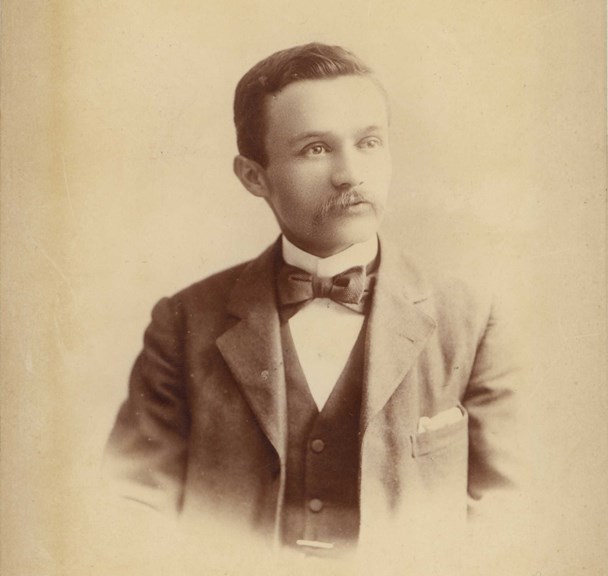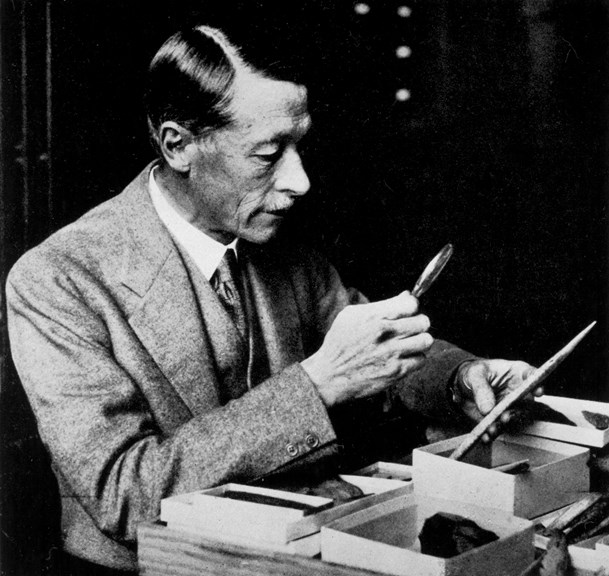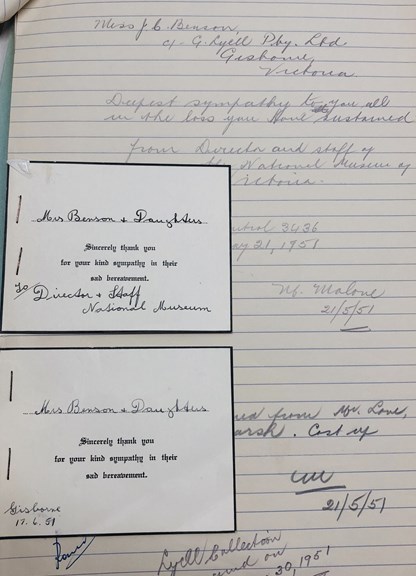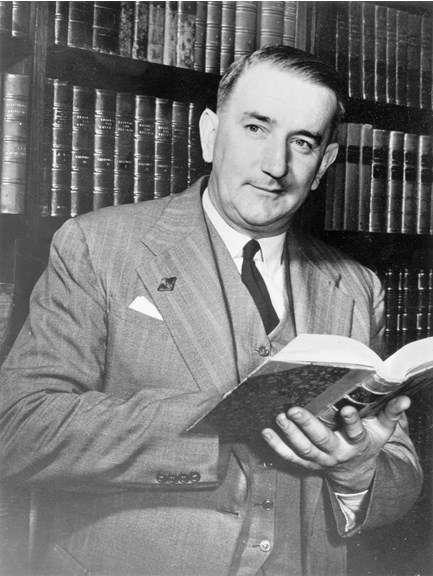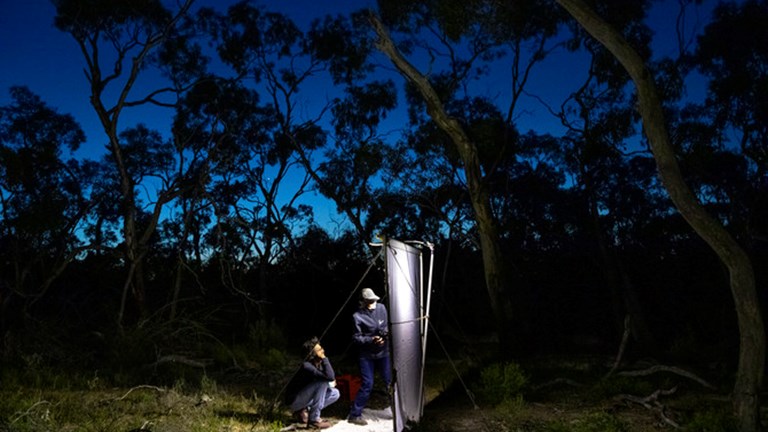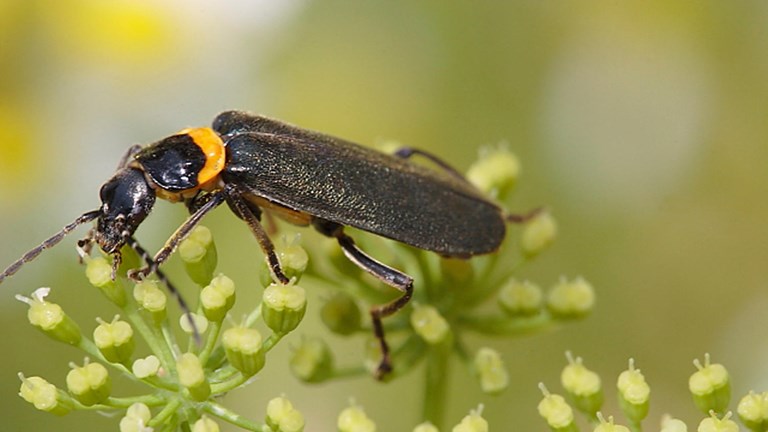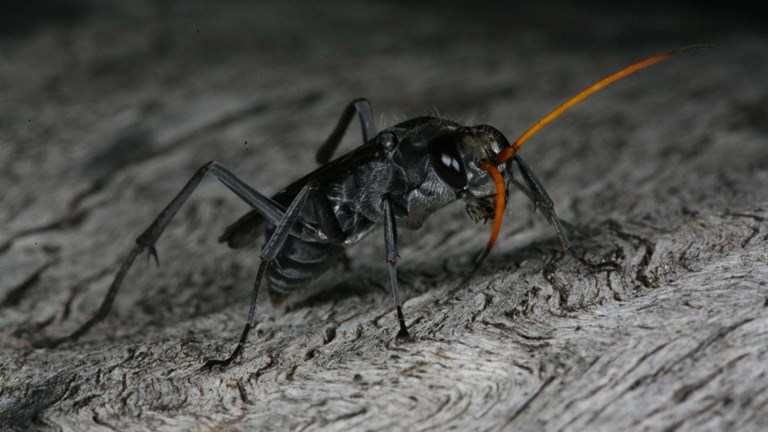The sting of the final letter
Although I knew I was getting close to the end of the file, and hence closer to transcribing the final documents noting Lyell’s passing on 19 May 1951, this did not soften the sting I felt.
Professor Coleman and I have transcribed many of George Lyell’s letters to get a sense of him as a person, collector, scientist and donor. Recently I completed transcribing the George Lyell Collection (1932 - 1952) file (AB 579) in the Museums Victoria Archives. Although I knew I was getting close to the end of the file, and hence closer to transcribing the final documents noting Lyell’s passing on 19 May 1951, this did not soften the sting I felt. The archive can be a very intimate place and I felt close to Lyell after studying his many years of correspondence with the National Museum of Victoria.
Lyell’s correspondence was honest, sometimes painfully so. He demanded perfection in his dealings with the Museum. He was dedicated, relentless, hardworking and passionate about his work transferring, rearranging, rehousing, relabelling and documenting the donation of his Lepidoptera Collection to the Museum. Between 1932 and 1946 Lyell incorporated his large collection into the Museum’s much smaller collection. He built cabinets and drawers, and arranged transportation of these items by train between Gisborne and Melbourne. He spent years of his life dedicated to the task, which often involved re-setting and re-labelling individual specimens. Evenings and weekends, every spare moment free from his paid employment as partner in the manufacturing firm Cherry & Sons, were devoted to this task.
The beginning of the great transfer
In 1932 Lyell contacted Daniel Mahony, Director of the National Museum of Victoria, after the removal of his prostate gland had left him bed-ridden. He was 65 years old, and the seriousness of this health scare prompted him to speed up the transfer of his Australian Lepidoptera collection to the Museum. Since his collection was the largest of its kind he was well aware of the importance of the work ahead of him, as well as its magnitude. Happily Lyell went on to live for another 19 years, during which time he worked for the National Museum as an Honorary Associate.
Here is Lyell’s letter to Daniel Mahony from File: Collections – George Lyell Collection – 23 July 1932 to 15 January 1952 [ARCHIVE-BOX~579].
‘Gisborne
19.2.1932
D Mahony, Esq
Director National Museum
Dear Sir,
In reply to yours of yesterday. I appreciate the honour and am pleased to fall in with your suggestion.
You have probably heard that last October I had to undergo an operation for bladder trouble (removal of the prostate gland). Though successful in a degree, full recovery is not yet + the Dr will not allow me on my feet – so I am writing this in bed.
This illness forced on my attention the necessity of taking steps for the early transfer of my collection (5100 species 45000 specimens) of Australian Lepidoptera – to your museum. There are quite a number of points in regard to this to be discussed and I had intended to bring them before you [the] first time I came to Melbourne, but when I can come down is still not certain. If at all possible I would suggest that you and Mr J Clark should motor up (32 miles on Bendigo Road) and talk the matter over with me. That would enable you both to look over the collection and to talk at leisure of its transfer to Melbourne.
Any day will suit me, but I am being treated from Dr Groves’ private hospital in Kyneton to which I have had to make five or six visits. So to make sure I am home it would be well to telephone Gisborne #7 (Cherry & Sons). If you are unable to raise them the Gisborne Postmaster will take a message & bring it along to me & ring you up with the reply later in the day.
Hoping to see you soon,
Very truly yours,
George Lyell [signed]
[PS] When coming up you might bring a Museum label to see how it [compares] in size and suitability with mine. I have visions of continuing the 2 collections and ending up [with] the finest collection of Australian Lepidoptera in existence.
Or if time permits a letter will be promptly [sent] and an appointment arranged.’
[Handwritten on top of Lyell’s letter-]
‘Mr Clark [met] Mr Lyell at Gisborne on 3.3.32 and discussed the transfer to the Museum of his collection. He is going into hospital on 6.3.32 and will begin the transfer as soon as he is able to get about once more. DM 4.3.32’
Transferring the collections: an intricate process
Transcribing Lyell’s letters, I celebrated his triumphs with him along the way. In a letter from Lyell to Mahony on 16 April 1941 [AB 579], after nine years of painstaking work, he wrote that he had finished with transferring the moth collection to the Museum. This numbered about 30 thousand specimens. The next stage was to transfer his butterfly collection to the Museum, about 10 thousand specimens.
In August 1944 Richard Pescott was appointed Director of the Museum. In the same month Pescott wrote to Lyell, asking him when he planned to transfer the butterflies to the Museum. There had been two and a half years of silence. The file contains no letters from Lyell to the Museum, or vice-versa, which struck me as odd. One explanation for the lack of correspondence during this period may have been the final stages of World War II, an effort in which both Lyell and the National Museum were involved.
Entomologist John Clark resigned from the Museum in 1944 when Pescott was appointed. As can be seen in the letter transcribed above, Clark had been in contact with Lyell about the transfer of his collection, and it was Clark who travelled to Gisborne in 1932. Clark left the Museum because his request for his position to be reclassified was denied. Daniel Mahony also left the Museum, retiring on 31 July 1944. Sadly he died a short time later on 27 September 1944 at the age of 68. In the years that followed, it was Pescott who worked with Lyell to complete the transfer of the butterfly collection. He showed Lyell every kindness and attended to his every need. In 1946 Lyell completed the transfer of the butterfly collection, but his work as a collector would only end with his death. Pescott and Lyell continued to correspond, along with Entomologist Alexander Noble Burns, who took over Clark’s position. Burns was Entomologist at the National Museum of Victoria from 1944 to 1959, then Assistant Director of the Museum from 1959 to 1964.
Burns and Lyell enjoyed a good relationship. Unfortunately the same cannot be said of Clark and Lyell. It was hard to get along with Clark. His manner was difficult, and his personal life was desperately sad.
Vale George Lyell
On 10 May 1951, Miss J. C. Benson of Gisborne wrote to Pescott saying ‘He [Lyell] has certainly surprised us the way he has improved. How long it will last is hard to say.’ My heart skipped a beat at the next letter in the file. It was from Mr Malone, Pescott's Secretary, sending sympathy from the Museum to Miss Benson.
‘Miss JC Benson,
c/- G Lyell Pty Ltd
Gisborne,
Victoria
Deepest sympathy to you all in the loss you have sustained.
From Director and staff of the National Museum of Victoria.
Sent for 3436
On May 21, 1951
M Malone
21/5/51
Wreath ordered from Mr Love, Bacchus Marsh. Cost up to £1/1/0/
MM [signed]
21/5/51
RTM [signed]
Lyell Collection received on May 30, 1951
MM [signed]’
‘Mrs Benson and daughters
Sincerely thank you for your kind sympathy in their sad bereavement.
To Director and staff
National Museum’
‘Mrs Benson and daughters
Sincerely thank you for your kind sympathy in their sad bereavement’
Gisborne
17.6.51’
Lyell’s wife Fanny had passed away before him, so presumably Miss Benson was Lyell’s carer or perhaps his companion in those final years.
Lyell’s passing, aged 84, was commemorated with obituaries in the Weekly Times (Melbourne) “Noted Naturalist, Dies”; The Sun (Sydney) “Australian butterfly and moth expert George Lyell died”; The Mercury (Hobart) “Prominent Naturalist Dies”. The Herald (Melbourne) published an extended obituary on 19 May 1951:
Death of Noted Naturalist – One of Australia’s best known naturalists, Mr George Lyell, died at his home in Gisborne early today, aged 84. His lifetime collection of Australian butterflies and moths, numbering over 52,000 specimens, was presented to Melbourne’s National Museum in 1946. Although the museum has been exhibiting fresh cases in the main hall every fortnight for the past four years, it has not yet been through the whole collection. Mr Lyell named several hundred new species of moths and butterflies in his life time. With the late Mr GA Waterhouse, of Sydney, he published, in 1914, the standard work on Australia’s butterflies.
In the Report of the National Museum of Victoria 1951 (DOC/17/633 p.9), Pescott wrote a heartfelt tribute to Lyell:
It is with regret that I have to record the death of George Lyell, Esq. at Gisborne on May 19, 1951. George Lyell, who was an Honorary Worker of the Museum for 19 years, commenced scientific butterfly collecting when a lad of 22 years of age, and in the 63 years that followed he amassed one of the finest collections of Australian Lepidoptera ever put together. In 1932, he offered his very large collection as a gift to the State of Victoria, and commenced the tremendous task of transferring this collection to the National Museum and at the same time amalgamating it with the Museum collection. At the time of his death, the Lyell Collection contained 11,721 butterflies and 39,495 moths, a total of 51,216 specimens representative of 6,177 species and including 534 types. The Lyell Collection of Australian Lepidoptera will for ever remain a monument to the industry, patience and ability of one of Australia’s notable sons.
At Museums Victoria
The George Lyell Archive at Museums Victoria Archives includes the portrait of Lyell as a young man (see portrait at top of blog), as well as his correspondence files, letter books and index book (1891–1951); Butterflies of Australia manuscript (co-authored with G. A. Waterhouse), index cards, plates, notes and book reviews; Lepidoptera collection notebooks and specimen lists. Lyell corresponded with collectors and scientists from around Australia and overseas, such as H. L. White, G. A. Waterhouse, A. J. Turner, F. P. Dodd and A. Mason. The Museums Victoria Library includes two monographs Butterflies of Australia (one annotated) in the Rare Book Collection. The State Collection includes Lyell’s Lepidoptera Collection.
The George Lyell Collection: Australian Entomology Past and Present McCoy Seed Funding Project is led by Professor Deirdre Coleman, School of Culture and Communication at the University of Melbourne. Nik McGrath, Archivist, Museums Victoria, is the coordinator at Museums Victoria, with colleague Simon Hinkley, Collection Manager, Entomology and Arachnology. I would like to introduce Alex Hankinson, a PhD in natural history in the Romantic Period, who has just joined the project team and will be moving from Sydney to Melbourne at the end of May.
Written by Nik McGrath, archivist, Museums Victoria
If you’re interested in learning more about the project, see our previous articles Butterflies of the night, Like moths to a flame and Pressed orchids.
